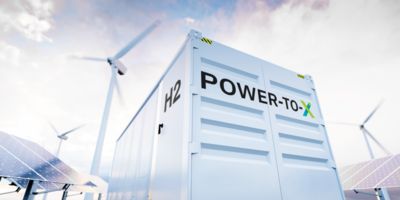What is power-to-gas? The power-to-gas (PtG/P2G) technology promotes the energy transition by contributing to grid stability and making renewable energy more efficient.

Brief summary
Power-to-gas converts renewable energy into hydrogen through electrolysis, which is used directly or converted to methane by reacting it with CO₂. This technology enables the storage of renewable energy, feed-in into the natural gas grid, stabilizes power grids, and promotes sector coupling through the versatile use of gas in various industries.

How does power-to-gas work?
The process is based on electrolysis, an electrotechnical process in which an electric current is used to split water down into its separate molecules. Clean hydrogen is released, which is a diverse energy source. With PtG, it is then converted into methane in a further step, for example by combining it with CO₂ that has been captured through carbon capture.
This process is called methanization. The resulting synthetic gas can be fed into the existing natural gas grid or used in various industrial applications.
Possible applications of power-to-gas
One of the main applications lies in energy storage. Instead of storing energy in batteries, power-to-gas enables the storage of electrical energy in the form of hydrogen or methane. Synthetic methane can be used for heating and generating electricity. At the same time, gas is an alternative to fossil fuels in industry, because it can be used in the same infrastructures.
The hydrogen produced can also be used in various industries, from steel production to chemical processes. It can also be used in mobility –for example, for refueling fuel-cell powered vehicles that can be operated without emissions.

Power-to-gas influences the energy transition
Power-to-gas facilitates the integration of renewable energies into the existing energy system and ensures year-round availability. At the same time, it enables a seamless connection between electrical, gaseous, and mobile forms of energy. This contributes to the stability of the power grids and, for example, reduces the need to derate the output of solar parks and wind farms.
Furthermore, the technology promotes the transition to an emission-free economy, as the gases produced can replace fossil fuels. PtG creates connections between the various sectors of the power supply and drives technological innovations that increase the efficiency of power generation and the use of this power.
The advantages of power-to-gas
Instead of wasting unused energy, PtG converts it into usable gaseous fuels that can be drawn upon when necessary. The process of methanization captures CO₂ and converts it to methane, which helps to reduce greenhouse gas emissions. The hydrogen and methane generated can be used in a variety of ways – for example in industry, in transportation, and for the heat supply. This technology therefore contributes to sector coupling. In addition, the existing natural gas grid can be used for storage and transport. Expensive investments in new infrastructures are avoided.
Summary
PtG/P2G supports a sustainable and future-proof power supply. The technology promotes the transition to an omission-free economy by replacing fossil fuels with climate-neutral alternatives, thereby significantly reducing greenhouse gas emissions. Given the global efforts to combat climate change and promote renewable energy, power-to-gas is a key building block of the All Electric Society, because the technology enables a sustainable power supply and supports the transition to a zero-emission economy.
Connect with our experts

More posts

What is power-to-X?
Power-to-X makes it possible to make electricity from the sun and wind storable and transportable.

What is power-to-heat?
Power-to-Heat (PtH/P2H) describes a process in which excess electrical energy is converted into heat. This heat can be provided for direct use or fed into a heat storage system.

The All Electric Society – how sector coupling works
Flexibility with a battery storage system and energy management.



